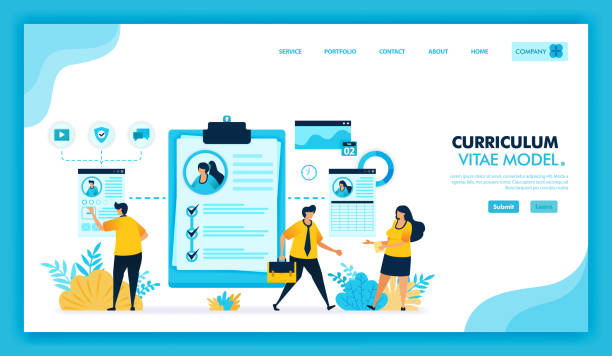Why is Responsive Web Design Important?

In today’s world, where users interact with the web through countless devices, from smartphones and tablets to laptops and smart TVs, providing a seamless and optimized user experience has become more vital than ever.
Responsive Web Design is the answer to this pressing need.
This approach means building a website that can intelligently adapt itself to the screen size and features of the user’s device, without compromising content quality or usability.
It’s not just a luxury feature; it’s a necessity for businesses to survive in the online space.
You can no longer expect users to constantly zoom in or perform unnecessary horizontal scrolling to access your content.
#Smooth_User_Experience, #Easy_Access, and #High_Efficiency are three fundamental pillars ensured by the correct implementation of this approach.
This technique allows developers to maintain a single codebase that dynamically optimizes for any device, which not only simplifies management but also reduces costs.
The importance of this issue is such that Google also prefers responsive websites in its rankings, which directly impacts your visibility in search results.
In other words, ignoring the principles of responsive design means losing a large portion of your audience and business opportunities.
Are you worried that your company’s old website is driving away new customers? Rasaweb solves this problem with modern and efficient corporate website design.
✅ Increases your brand’s credibility.
✅ Helps attract targeted customers.
⚡ Contact Rasaweb for a free consultation!
The Evolution of Web Access and the Need for Responsiveness

The history of the web has traversed a winding path, from the early days when pages were designed only for desktop monitors, to today when billions of people connect to the internet via their mobile phones.
Initially, websites were designed with fixed widths, and it was assumed that all users would have a similar experience.
However, with the advent of smartphones and tablets in the 2000s, this perception completely transformed.
Suddenly, users entered the scene with much smaller screens and touch capabilities.
This shift created significant challenges for web designers; older websites were simply unusable and led to a very poor user experience.
Some companies moved towards separate mobile versions (m.sites), but this solution also came with challenges such as managing two codebases, SEO issues, and content inconsistency.
This is where the concept of Media Queries and subsequently Responsive Web Design was introduced by Ethan Marcotte in 2010.
This revolutionary approach promised that a single website could be optimized for all devices, eliminating the need for separate versions.
The adoption of this idea rapidly expanded, and now responsive design has become an industry standard.
This evolution signifies the increasing importance of accessibility and providing a flawless experience for every user, regardless of their device.
This paradigm shift has guided the web towards a more flexible and inclusive future.
Fundamental Principles of Responsive Web Design and Implementation Techniques

The implementation of Responsive Web Design is based on three key principles: Fluid Grids, Fluid Images, and Media Queries.
Fluid grids mean that your website’s layout is designed based on percentages and relative units (such as em or rem) instead of fixed pixels.
This allows elements to scale automatically as the screen size changes.
Flexible images also ensure, using CSS and properties like max-width: 100%, that images never overflow their container and scale correctly with screen size changes.
However, the main pillar of this type of design is Media Queries or Media Queries.
These CSS directives allow developers to apply different style rules based on device characteristics such as screen width, height, orientation (portrait or landscape), and even resolution.
For example, you can define that for screens smaller than 768 pixels, column layouts change or fonts become smaller.
Proper use of Flexbox and CSS Grid is also highly effective in creating complex yet flexible layouts.
These techniques provide more precise control over how elements are displayed on various screen sizes and facilitate the implementation of an adaptive website.
| Feature | Fixed Design | Responsive Design |
|---|---|---|
| Device Compatibility | Limited to desktop | Compatible with all device types |
| Code Management | May require separate versions | A single codebase |
| User Experience | Poor on mobile | Optimized and smooth across all devices |
| SEO | May rank lower | Positive score from search engines |
User Experience and SEO Benefits with Responsive Design

Responsive Web Design, beyond a technical discussion, is a powerful strategy for improving user experience (UX) and search engine optimization (SEO).
From a user’s perspective, a responsive website means eliminating the need for zooming, annoying horizontal scrolling, and layout inconsistencies.
Content adjusts automatically and intelligently to the screen size, which leads to ease of reading, simple navigation, and greater user satisfaction.
When users have a good experience on your website, they are more likely to return and spend more time on the site, which are positive signals for search engines.
In the field of SEO, Google has explicitly stated that it prefers responsive websites over separate mobile versions.
The reason for this is the simplicity in crawling and indexing a single URL.
By having one URL for all devices, duplicate content issues are avoided, and backlink authority is concentrated at a single point.
This significantly helps improve your keyword rankings.
Additionally, page loading speed on mobile devices, a crucial ranking factor, improves with necessary optimizations in responsive design.
In summary, investing in responsive design not only pleases your users but also directly impacts your SEO visibility and success.
Falling behind in competition with large online stores?
Rasaweb, with professional e-commerce website design, brings your business online and increases your market share!
✅ Boosts brand credibility and customer trust
✅ Easy shopping experience leads to more sales
⚡ Act now for a free website design consultation!
Common Challenges and Pitfalls in Implementing Responsive Design

Despite its numerous benefits, implementing Responsive Web Design is not without its challenges and can present developers with specific pitfalls.
One of the biggest challenges is content management across different screen sizes.
Should all desktop content be displayed on mobile? Sometimes, removing or reordering certain elements is necessary to improve the mobile experience, but these decisions must be made carefully and based on content prioritization.
Navigation complexity is also a common issue; large desktop menus often need to be converted into a hamburger menu or other patterns, which can reduce accessibility if not implemented correctly.
Another concern is website Performance.
Although responsive design has a single codebase, if images are not optimized or heavy CSS and JavaScript files are used, the site can perform slowly on mobile devices.
Is it always best to use a high-resolution image for all devices? No, solutions like adaptive images or Lazy Loading should be considered.
Is testing a website across all devices and browsers truly feasible? This is a time-consuming and difficult process and requires comprehensive testing tools and strategies.
Neglecting these challenges can lead to an undesirable experience for mobile users, even if the site is seemingly ‘responsive’.
Understanding these pitfalls and planning to address them is crucial for success in responsive design projects.
Popular Tools and Frameworks for Responsive Web Design
![]()
To facilitate the process of Responsive Web Design, a wide range of tools and frameworks have been developed to help designers and developers build websites compatible with various devices more quickly and efficiently.
Bootstrap is undoubtedly one of the most popular and widely used front-end frameworks, enabling the creation of responsive websites using a 12-column grid system, pre-built UI components, and JavaScript plugins.
Foundation is another powerful framework that emphasizes a mobile-first approach and provides comprehensive tools for responsive UI design.
In addition to these comprehensive frameworks, more specialized tools also exist.
For instance, CSS preprocessors like Sass and Less allow for the use of variables, functions, and nesting, which significantly simplifies the management of CSS code in large responsive design projects.
Browser development tools (such as Developer Tools in Chrome) are also essential for testing and debugging layouts across various screen sizes.
For managing responsive images, solutions like using the <picture> tag or the srcset attribute in HTML5 allow developers to provide optimized images for different sizes.
The choice of framework and appropriate tools depends on the project’s complexity, the development team’s preferences, and the website’s specific needs, but all are designed to simplify and improve the process of creating an adaptive website.
Optimizing the Performance of Responsive Websites

Responsive Web Design alone does not guarantee optimal performance.
In fact, if not properly managed, a responsive website can perform slower than a fixed site due to excessive content loading for smaller devices.
Performance optimization for responsive websites is critically important, especially for mobile users who may be using slower internet connections.
One of the most important aspects is image optimization.
Using images with appropriate resolution for each device, intelligent image compression, and implementing Lazy Loading – which loads images only when the user needs them – can have a significant impact on speed.
Minification of CSS and JavaScript files, Dead Code Elimination, and the use of Content Delivery Networks (CDN) are also effective solutions.
Additionally, ensuring that Critical CSS is quickly loaded for the initial page render can improve the user experience.
Given that site speed is an important ranking factor for Google, focusing on performance alongside responsive design is essential for online success.
These optimizations ensure that your website not only displays well across all devices but also operates with high speed and efficiency, providing an unparalleled user experience.
| Optimization Technique | Brief Description | Impact on Performance |
|---|---|---|
| Image Optimization | Compression, suitable format (WebP), Lazy Loading | Reduced page loading time |
| Minification CSS/JS | Removing extra characters (whitespace, comments) | Reduced file sizes |
| Using CDN | Distributing content from servers closer to the user | Increased content delivery speed |
| Critical CSS | Inlining necessary CSS for the first page render | Improved First Contentful Paint (FCP) |
The Future of Responsive Web Design Beyond Today

The concept of Responsive Web Design, born with the goal of adapting to various screen sizes, is evolving to go beyond traditional devices.
The future of web design is moving towards an ‘adaptive web’ that responds not only to the physical dimensions of the screen but also to the user’s context and environment.
This includes factors such as internet connection speed, geographical location, time of day, and even user personal preferences.
Imagine a website that changes its color scheme based on ambient light, or adjusts the quality of images and videos based on the user’s internet speed.
The emergence of Artificial Intelligence (AI) and Machine Learning (ML) can also play a significant role in this area, with platforms automatically optimizing layouts based on user and device data.
New devices such as foldable displays, wearables, and even the Internet of Things (IoT) are also expanding the boundaries of this design approach.
These developments mean that websites must not only be responsive but literally become ‘smart’ and ‘context-aware’.
This requires deeper thinking about information architecture and user interaction in highly diverse environments to ensure that websites always provide the best possible experience.
This is an exciting future where websites will truly interact with users and their surroundings.
Are you frustrated by losing customers due to your e-commerce site’s outdated appearance or slow speed? Rasaweb’s expert team solves these problems with professional e-commerce website design!
✅ Increased customer trust and brand credibility
✅ Stunning speed and excellent user experience
Get a free consultation with Rasaweb right now ⚡
Successful and Influential Examples in Responsive Design

Examining real-world examples of websites that have successfully implemented Responsive Web Design can be a valuable source of inspiration and learning.
Many large and leading brands, including reputable news media, e-commerce platforms, and social networks, have made significant investments in responsive design.
For example, news websites like the BBC or The New York Times flawlessly adapt to any screen size, providing a smooth and distraction-free news reading experience.
They carefully adjust layout, font size, and image placement to ensure content is always readable and accessible.
In the e-commerce industry, many large online stores, using this design approach, have significantly increased their conversion rates on mobile devices.
These sites ensure that the shopping process, from browsing products to checkout, is easily accomplishable on smartphones.
Successful examples often employ a ‘Mobile-First’ approach, meaning that design begins for the smallest screens and then progressively expands for larger devices.
This approach ensures that the core user experience on mobile devices remains strong and optimized.
Analysis of these examples shows that success in responsive design is not limited to technical issues but requires a deep understanding of user behavior across different devices and the prioritization of content and functionalities.
By focusing on these principles, these websites not only meet technical requirements but also provide an enjoyable experience for users wherever they may be.
Practical Steps to Start a Responsive Web Design Project

To start a Responsive Web Design project, following a few practical steps can smooth the path.
The first and most important step is thorough planning and understanding your audience.
You need to know what devices your users are on and what their needs are.
A ‘mobile-first’ approach is highly recommended; start your design with the smallest screens and then move towards desktop.
This ensures that your mobile experience will be strong and efficient.
In the design phase, instead of fixed pixels, use relative units (such as percentages or em/rem) for widths, paddings, and margins.
For images, always use max-width: 100% and provide optimized images for different dimensions.
Implementing Media Queries to adjust layout and styles at various breakpoints is the heart of this design approach.
After design and development, comprehensive testing is essential.
Test your website across different browsers and devices (including emulators and real devices) to ensure correct functionality in all scenarios.
Tools like Google PageSpeed Insights can help you identify performance issues.
Finally, web design is a continuous process.
As technology and user behavior change, further updates and optimizations may be needed.
By following these steps, you can create a responsive and successful website that provides an excellent user experience on any platform.
This approach helps you have an adaptive and future-proof website.
Frequently Asked Questions
| Question | Answer |
|---|---|
| What is Responsive Web Design? | It is a web design approach aimed at creating websites that can automatically adapt to the screen size and device of the user (computer, tablet, mobile) and provide the best user experience. |
| Why is responsive design important? | Its importance has increased due to the growing variety of devices people use to access the internet. This design improves user experience, boosts search engine rankings (SEO), and reduces maintenance costs. |
| How is responsive design implemented? | By using CSS techniques such as Media Queries, which allow you to change styles based on device characteristics (like screen width), Fluid Grids, and Flexible Images. |
| What are the key principles of responsive design? | The three main principles are: Fluid Grids (using relative units like percentages instead of pixels for widths), Flexible Images (adapting image sizes to available space), and Media Queries (applying different styles based on screen characteristics). |
| What are the benefits of having a responsive website? | Providing a seamless user experience across all devices, improved SEO, increased user time on site, reduced bounce rate, and easier site management and updates (only one codebase). |
And other services of Rasaweb advertising agency in the field of advertising
Smart Conversion Rate Optimization: A professional solution for customer acquisition with a focus on precise audience targeting.
Smart Sales Automation: A professional solution for increasing click-through rates with a focus on using real data.
Smart Marketing Automation: A dedicated service for campaign management growth based on user experience customization.
Smart Google Ads: Designed for businesses looking to increase sales through attractive user interface design.
Smart Advertising Campaign: Designed for businesses looking for digital branding through user experience customization.
And over hundreds of other services in the field of online advertising, advertising consulting, and organizational solutions
Online Advertising | Advertising Strategy | Advertorial
Resources
What is Responsive Web Design?The Importance of Responsive DesignResponsive Website DesignResponsive Website and Its Benefits
? Rasaweb Afarin, your strategic partner in the digital world. From search engine optimization to multilingual website design and content marketing, we ensure the growth and visibility of your business.
📍 Tehran, Mirdamad Street, next to Bank Markazi, Southern Kazeroon Alley, Ramin Alley, No. 6

